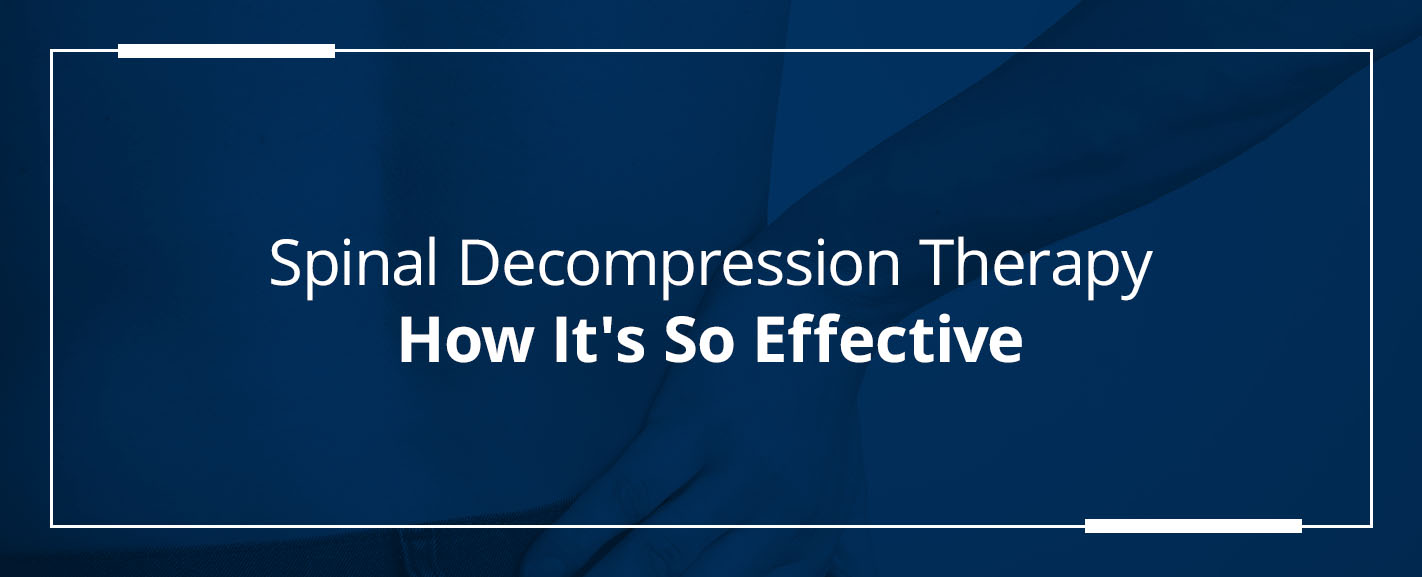
Spinal Decompression Therapy — How It’s So Effective
Chronic back pain affects millions of Americans each year, causing discomfort and an inability to enjoy daily life to the fullest. In addition to physical pain, many people who experience back pain also notice various emotional side effects, such as anxiety, depression or general low mood. For many people, chronic back pain affects every aspect of their lives.
Back pain can cause a limited range of motion and greatly decrease a person’s mobility, interfering with their personal and professional responsibilities. Fortunately, as technology advances, there are many innovative spinal treatments available designed to improve pain and discomfort. Learn more about spinal decompression therapy and how it may help your spinal pain.
What Is Spinal Decompression Therapy?
Spinal decompression therapy is a nonsurgical spinal treatment using motorized traction therapy to safely and effectively elongate and stretch the spine. Nonsurgical spinal decompression can alleviate tension and pressure from the sensitive spinal disks and nerves, helping to relieve pain and discomfort.
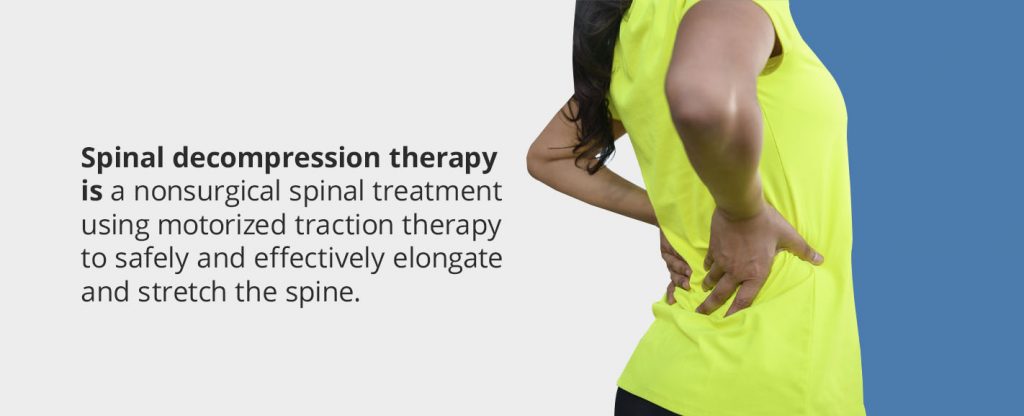
The gentle decompression of the spine can improve circulation, blood flow and nutrient exchange to injured portions of the spine. There are several cycles of stretching and relaxing during a nonsurgical spinal decompression treatment. Each session can provide additional relief of tension and help decompress the spine.
Like other nonsurgical spinal treatments, decompression therapy is performed by a trained professional on a table. The patient will wear a harness around the lower back, controlled via a computer by your physician. This computer can gently stretch the spine, allowing fluid to enter the disks, which have been constricted because of spinal compression. The fluid helps promote healing within the spine and reduce pressure.
Many nonsurgical spinal decompression patients require multiple treatments for optimal results. While each patient’s treatment schedule will vary, the average patient may need to come info three times a week for four weeks, totaling 12 sessions. Many patients begin noticing small improvements in pain and discomfort within a few sessions.
How Spinal Decompression Works
This type of therapy uses the fundamental principle of spinal traction, which is traditionally provided by osteopaths and chiropractors. Spinal decompression aims to promote an optimal healing environment for damaged, unhealthy or slipped disks. Spinal decompression can help achieve lower pressure in the disk, resulting in additional nutrients being able to reach the disk and promote healing.
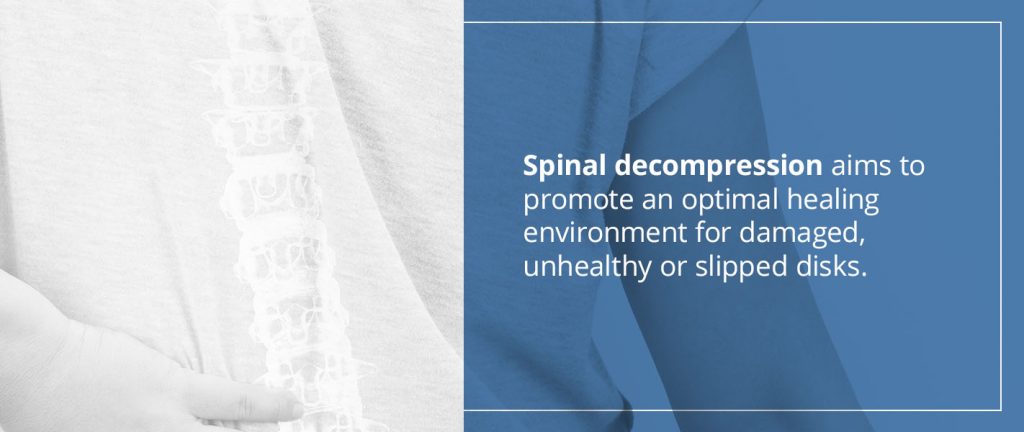
Another goal of nonsurgical spinal decompression is to achieve negative pressure between the disks to help reposition slipped, bulging or misplaced disks and disk material. Patients can undergo spinal decompression while being fully clothed, as a physician can put the harness over clothing around the pelvic region.
After the harness is in place, the patient can lie on the table face up or down. The doctor will use a computer to perform the treatment and will customize the therapy to fit the patient’s unique needs. The doctor will also determine how many treatment sessions are necessary.
What Spinal Decompression Therapy Treats
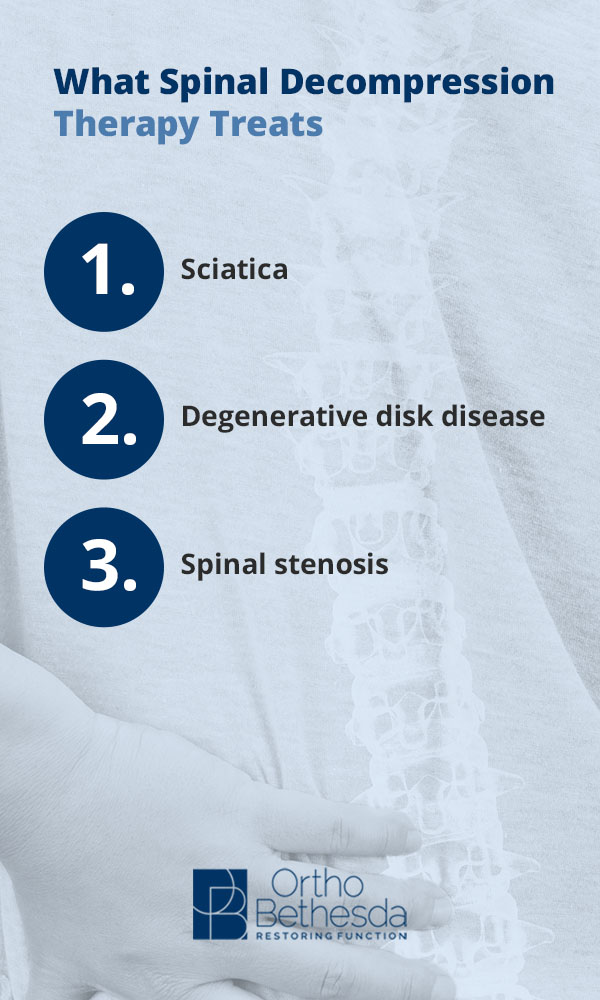
Nonsurgical spinal decompression therapy is an innovative treatment designed to alleviate upper, middle and low back pain discomfort and compressions. Spinal decompression is often suggested if you are experiencing pain, weakness, numbness or a limited range of motion.
Some of the main conditions spinal decompression may be used to treat include:
- Sciatica: Sciatica can cause pain that radiates along the sciatic nerve’s path, which stems from the lower back through the buttocks, hips and down the legs. Sciatica may only affect one side of the body, but it can occur on both sides of the body. Many people develop it when the nerve is compressed, resulting from herniated disks, spinal stenosis or bone spurs.
- Degenerative disk disease: While disk degeneration is a normal aspect of aging, degenerative disk disease refers to degenerated disks that cause pain, discomfort and other symptoms. Studies have found approximately 30% of people by the age of 35 will show signs of disk degeneration. One of the most common symptoms of degenerative disk disease includes pain that feels worse when sitting, bending, lifting or twisting.
- Spinal stenosis: Spinal stenosis is when the spaces within the spine are narrowed, applying pressure on the nerves that travel through the spinal column. In most cases, spinal stenosis develops in the neck and the lower back. While some people with spinal stenosis may not display symptoms, others may experience numbness, tingling, muscle weakness and pain.
What Causes Back Pain
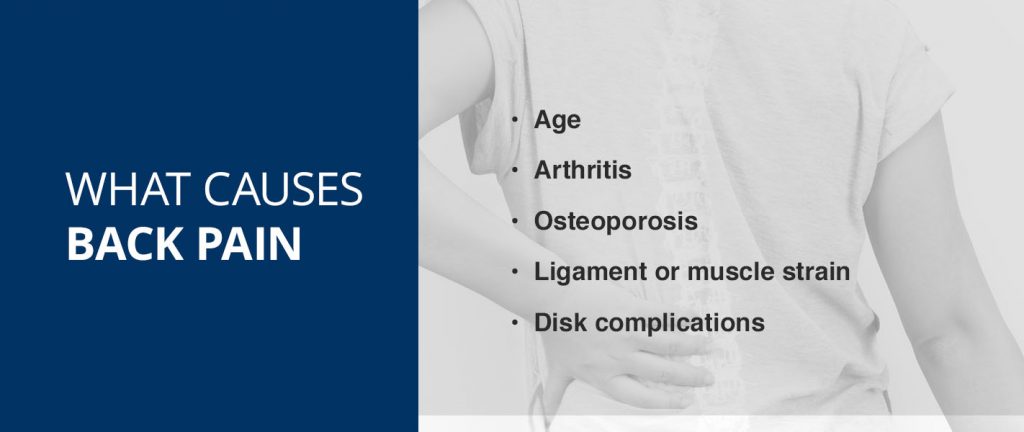
Numerous conditions may contribute to or worsen back pain. Understanding what is causing your back pain can help you determine what treatments may help you relieve spinal tension, pain or discomfort. The spine is a complex part of our body and contains many bones, nerves, muscles and ligaments. If any of these spinal components become compressed or damaged, pain is likely to occur.
Some of the most common causes of back pain include:
- Age: Age is one of the largest contributing factors. Back pain is common as we age because the body begins to become more fragile over time. As you age, your spine continues to change and may become more susceptible to stiffness or pain. Age-related back discomfort and pain are typically caused by general degeneration of the spinal joints, causing bones to painfully grind against one another.
- Arthritis: Spinal osteoarthritis can develop in the facet joints located in the back, which link each bone vertebra. The spinal bones, or vertebrae, and intervertebral disks make up the spinal column, along with the vertebral joints and cartilage lining. The joints and vertebrae may not have as much cushion from wear and tear, causing the bone to come into contact with bone, which can be very painful. Many types of arthritis affect the back.
- Osteoporosis: Osteoporosis is a common condition, affecting around 10 million people over the age of 50. While osteoporosis is known to largely affect women, it’s also a concern for older men. Osteoporosis causes the bones to become weaker and more prone to breaking or fracturing. The resulting fractures that may occur within the spine are what cause painful symptoms.
- Ligament or muscle strain: There are two soft tissue injuries that can occur in the back — muscle and ligament strains. Muscle strains are when the muscle fibers tear from repeated use or overstretching. A muscle strain is more commonly known as a pulled muscle. The other type of soft tissue injury is known as a lumbar sprain, which is when the ligaments are torn or stretched.
- Disk complications: The intervertebral disks cushion each vertebra and protect them from coming into direct contact. Disk-related problems can cause back pain because the protective material of the disks is either degenerated, slipped or damaged. Some of the most common types of back pain include disk strain, disk protrusion, sciatica and degenerative disk disease.
Is Spinal Decompression Therapy Effective?
Research has found 86% of patients who received spinal decompression therapy for a ruptured disk said they experienced good to excellent results. While traditional chiropractic and physical therapy treatments may provide temporary relief, only nonsurgical spinal decompression therapy has been found to create negative pressure within the spine.
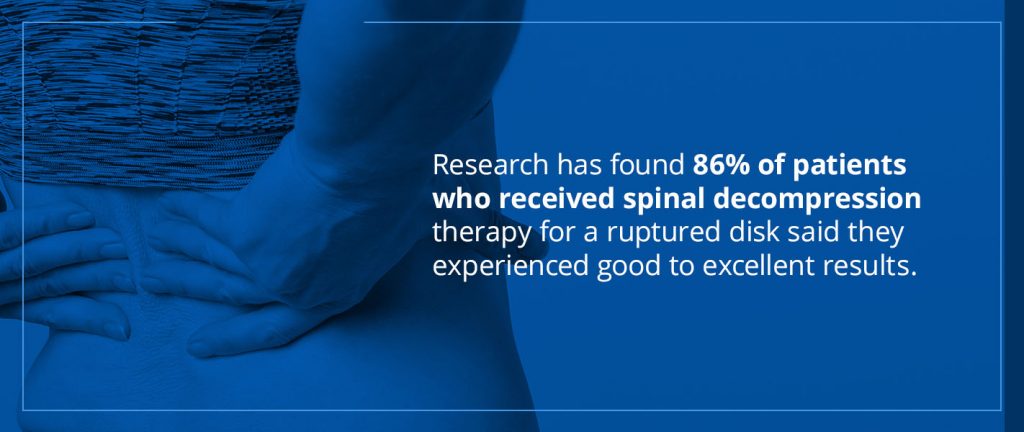
Traditionally, a pulling sensation would cause the spine’s sensory receptors to trigger, tightening the muscles around the disks and vertebrae in an attempt to protect them from potential injury. This process is known as the proprioception response. However, spinal decompression therapy can bypass this immediate response by slowly and gently elongating the spine and letting the spine relax over periods of time.
These sessions of activation and rest allow the spinal disks to naturally reposition without tension or pressure, initiating muscle spasms or a muscle guarding response. Spinal decompression therapy is a versatile treatment modality that can help alleviate pressure, pain and discomfort related to various spinal conditions.
Benefits of Spinal Decompression Therapy
Back pain is a common medical problem. Because many of us work physically demanding jobs or spend a large portion of our days sitting, our spines are much more likely to compress, creating tension and discomfort. Spinal compression can lead to disk degeneration and other medical complications that cause chronic pain.
Fortunately, spinal decompression is a noninvasive treatment that can help relieve built-up pressure and tension, allowing people to experience back pain relief. Unlike medication or other treatment modalities, nonsurgical spinal decompression can improve pain at its source instead of just masking symptoms.
Some of the benefits of spinal decompression therapy include:
- Nonsurgical treatment: One of the main benefits of spinal decompression therapy is it’s a nonsurgical treatment, meaning patients do not have a long recovery period or downtime associated with traditional surgery. While spinal surgery is an effective treatment that may be right for some patients, most physicians suggest nonsurgical treatments to see if patients experience relief without undergoing extensive surgery. The majority of patients can return to their daily activities or work immediately after treatment.
- Alleviate pain and tension: This therapy can improve tension and pain caused by spinal pressure or compression. Many patients find relief from chronic back pain following multiple sessions of spinal decompression therapy, allowing them to enjoy daily life more. Without chronic back pain, patients can enjoy a wide range of motion and a greater level of mobility.
- Versatile therapy: This is a versatile treatment that can improve back pain caused by many spinal conditions. Some of the most common spinal conditions decompression therapy can improve include sciatica, degenerative disk disease and pinched spinal nerve roots. Bulging, slipped or herniated disks also respond well to spinal decompression therapy.
- Long-term results: Spinal decompression therapy’s goal is to provide long-term results for patients, improving their overall quality of life. While patients may need multiple or ongoing sessions, spinal decompression therapy helps provide long-term relief.
Spinal Decompression Therapy Risks
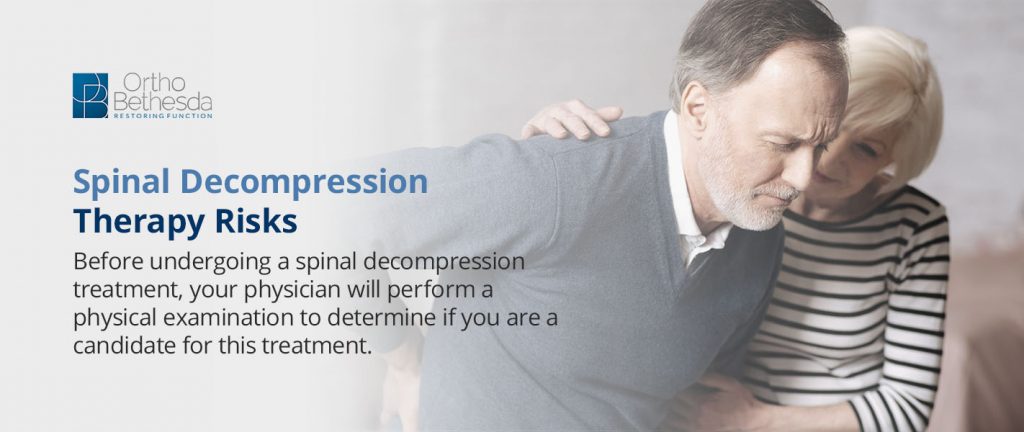
Although spinal decompression is an innovative, effective treatment for those experiencing back pain, it may not be the right procedure for all patients. As with any medical procedure or treatment, spinal decompression therapy does have potential risk factors to consider. Fortunately, the risk of complications with nonsurgical spinal decompression is very low.
Before undergoing a spinal decompression treatment, your physician will perform a physical examination to determine if you are a candidate for this treatment. In some cases, medical imaging tests, such as X-rays or magnetic resonance imaging (MRIs), may be necessary to determine your eligibility. Medical imaging can help determine if you have a spinal condition that requires alternative treatment.
It’s important to note the potential risk of spinal decompression therapy. While unlikely, some patients may experience pain after spinal decompression therapy. In this case, a physician will likely suggest seeking an alternative treatment that may be more effective. In addition to pain, some patients may experience muscle spasms or contractions following treatment. In other cases, patients may notice pain that radiates down their arms or legs.
Always inform your doctor of any side effects you’re experiencing so they can modify your treatment plan.
Who Should Consider Spinal Decompression Therapy?
This therapy may be ideal for patients experiencing ongoing or chronic back pain. Patients who experience back pain from spinal pressure or compression may be ideal candidates for spinal decompression therapy. Spinal decompression is generally recommended for most patients in otherwise good health.
Note that there are certain conditions that may benefit from alternative treatments or surgical intervention. During a consultation, a spinal specialist can help determine the cause of your back pain and if you’re an ideal candidate for non-surgical spinal decompression therapy.
Spinal decompression is not recommended for pregnant women or women who may become pregnant, as this procedure causes slight pressure on the abdomen. Spinal instability from spinal degeneration, advanced osteoporosis or other conditions may also cause patients to be ineligible for these treatments.
Patients who have undergone previous spinal surgery will need to discuss the details of their past procedures to determine if they are ideal candidates. Unless the bone has been fused, the use of metal plates, screws or similar hardware may cause a patient to be ineligible for spinal decompression therapy.
Other conditions that may cause a person to be ineligible for spinal decompression include severe nerve damage, grade 3 or 4 spondylolisthesis or disk space infections. Patients with a history of aortic aneurysm or metastatic cancer that has spread to the bone may not be ideal candidates, either.
What to Expect From Spinal Decompression Therapy
Spinal decompression therapy aims to achieve pain relief by promoting an optimal healing environment for multiple spinal conditions, including degenerative, slipped, bulging or ruptured disks. It can improve circulation and blood flow to the spinal disks, moving oxygen and nutrient-rich fluids toward damaged portions of the spine.
This improved circulation can promote tissue repair, cell renewal and long-term improvement and healing. A spinal decompression treatment works by gently and steadily stretching the spinal column to reduce the amount of pressure on the spinal disks, creating negative pressure in the spine. Spinal decompression can create a reverse vacuum that helps reposition a protruding or slipped disk back into its normal positioning.
Spinal Decompression Procedure
Three main components are used during spinal decompression, including a spinal decompression table, harness and computer. During a spinal decompression treatment, you remain fully clothed and have a harness fitted around your pelvis. You then lie down on the spinal decompression table.
The table provides a secure foundation for you to lie on while your spine is gently stretched using the harness and computer-guided technology. As a doctor operates the computer, the harness will safely elongate the spine and decompress tight vertebrae and intervertebral disks.
Spinal decompression therapy uses the same principles and technology that chiropractors and osteopaths have been using for decades to elongate the spine and relieve tension and pressure.
Spinal Decompression Recovery
Because spinal decompression is nonsurgical, there’s little to no recovery period associated with this treatment. Fortunately, most patients can immediately return to daily activities or work following a spinal decompression treatment.
Additionally, most patients receive multiple spinal decompression treatments a week, which signifies there is not much downtime associated with this treatment. Patients should begin to notice slight improvements following spinal decompression sessions. While some patients may notice improvement after a couple of sessions, some may need five or six sessions before they notice significant improvements.
What Is the Difference Between Surgical and Nonsurgical Spinal Decompression?
Despite nonsurgical spinal decompression therapy being an effective treatment for many patients, some may require spinal decompression surgery or other spinal surgeries to effectively alleviate pain and tension. There are multiple types of surgical spinal decompression, including laminotomy, foraminotomy, laminectomy, discectomy and laminoplasty.
Types of Surgical Spinal Decompression
There are multiple types of surgical spinal decompression, including laminotomy, foraminotomy, laminectomy, discectomy and laminoplasty:
- Laminotomy: Laminotomy is designed to remove part of the lamina and some surrounding ligaments. The unique aspect of laminotomy is only a small portion of the lamina is removed, rather than the entire lamina. Removing only a section of the lamina can promote spinal stability while relieving pain.
- Foraminotomy: Foraminotomy can help relieve pressure from compressed nerves by creating a larger space around the bones in the spinal column. This can be achieved by removing the bone that surrounds the neural foramen. Foraminotomy is often performed for patients with a ruptured or damaged disk, resulting in the foramen collapsing and compressing nearby nerves.
- Laminectomy: Spinal laminectomy is when a space is created in your spine by removing the lamina and any ligaments surrounding the lamina. Laminectomy is often recommended for those with overgrowth in the small canal, commonly seen in spinal arthritis.
- Discectomy: A discectomy can remove part of a damaged disk that causes pain and discomfort. Removing an unhealthy portion of a spinal disk can help relieve pressure on the surrounding nerves.
- Laminoplasty: A cervical laminoplasty relieves pressure and pain in the neck caused by the spinal cord. Neck pressure may be caused by bone spurs, tumors, arthritis, fractures and more.
Risks of Surgical Spinal Decompression
While spinal decompression surgery is an effective spinal treatment, there are potential risks to consider. Despite spinal decompression being safe, any surgery carries the risk of infection, negative reactions to anesthesia and more. Fortunately, these risks are small and often much less likely when performed by a certified spinal surgeon.
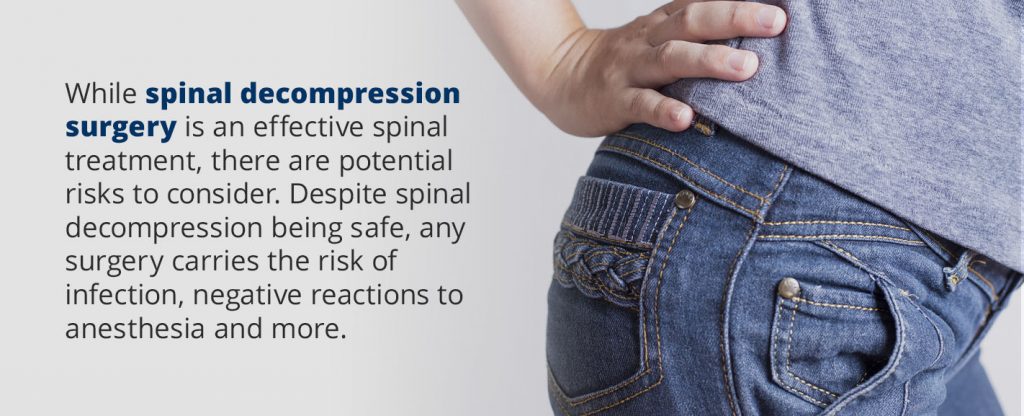
Some of the risks of spinal decompression surgery include:
- Infection: One of the most common side effects to be aware of is the potential for infection following surgery. Infections may occur where the incision was made. Fortunately, antibiotics can improve an infection.
- Anesthesia reaction: While not a reaction to the spinal surgery itself, some patients may react negatively to the anesthesia used during treatment. A common complication of anesthesia is a patient having minor breathing difficulties after surgery.
- Continuing or worsening symptoms: Unfortunately, some patients may not respond to spinal decompression surgery, and their symptoms may not improve. In the most severe cases, some patients may experience worsening symptoms following surgery. Fortunately, surgical spinal decompression is largely effective at alleviating pain.
- Cerebrospinal fluid leakage: Another risk of spinal decompression surgery is the potential for nerve damage, causing cerebrospinal fluid to leak. If this happens during surgery, it can be addressed and repaired to minimize damage. Minor leaks of cerebrospinal fluid may only become noticeable after surgery through headaches.
- Blood clots: Following spinal decompression surgery, there is a risk of blood clots. Bloods clots are more prone to developing in the legs, known as deep vein thrombosis (DVT). DVT can cause swelling and pain in the legs.
When Surgical Spinal Decompression Is the Best Choice
The decision to undergo spinal decompression surgery is something you and your physician can determine most accurately, as the solution will be different for each patient. In some cases, patients may not be eligible for nonsurgical spinal treatments or may require spinal surgery to improve their symptoms. It’s typically recommended for patients to undergo nonsurgical treatments first to see if they provide relief.
If patients experience severe pain or do not respond to nonsurgical treatments, they may want to consider spinal surgery as a potential treatment modality. More complex spinal injury cases or damage may need spinal surgery to appropriately address the underlying cause of pain.
Spinal Decompression Therapy at OrthoBethesda
At OrthoBethesda, our team of therapists, doctors and medical professionals strive to offer the highest level of patient care possible. We treat orthopedic conditions affecting multiple parts of the body, including the elbow, hip, knee, shoulder and more. We also offer various physical therapy services, such as concussion management, balance and fall prevention and more.
To learn more about our treatments and find out if spinal decompression therapy is right for you, contact us online today.

